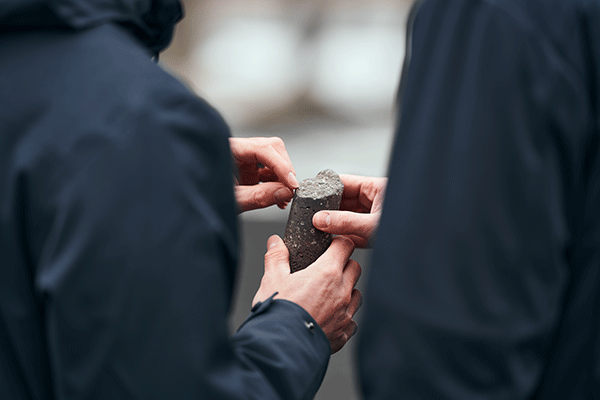A new direct air capture and storage plant has started removing carbon dioxide from the atmosphere, transforming it into stone and storing it permanently underground.
Run by Swiss start-up, Climeworks, Orca is a new facility that draws air through a giant fan and captures carbon dioxide day and night.
The venture’s Icelandic partner, CarbFix, has developed technology that turns carbon dioxide into stone. This mineralisation process involves dissolving carbon dioxide in water, effectively creating sparkling water, which gets pumped underground. Then reactors extract the carbon dioxide to form white particles of calcium carbonate within the basalt rock beneath the ground within two years.
The UN’s recent IPCC report indicated that scaling up carbon capture technologies could be a critical step to speeding up mitigation of the climate crisis.

Orca – named after the Icelandic word ‘orka’ which means energy – aims to remove 4,000 tonnes of carbon dioxide annually from the atmosphere. According to the US Environmental Protection Agency, that’s equivalent to a year’s worth of greenhouse gas emissions from 870 cars, or the carbon stored by 66,141 tree seedlings grown for a decade.
As Prime Minister of Iceland Katrín Jakobsdóttir explained at last week’s launch event in Hellisheidi, Iceland, decarbonisation is important but it isn’t enough on its own. “There’s no time to waste – this innovation is an important step in the race to net zero climate emissions,” said Jakobsdóttir, who emphasised the need to act globally with ambitious climate solutions.
“In the run up to COP26, we need all nations to roll up their sleeves and get to work. We need to take concrete actions, ambitious policies and actions, courageous governments to see them through and scientists and the private sector to lead the way with us,” she said.
“I’m convinced that the Orca project will help to encourage even bigger technological advancements in the future and inspire the world to believe in the incredible possibilities that science and technology offer us to the enormous problems we face.”
Orca took 15 months to build and the plant is run solely on renewable geothermal energy. It follows a pilot project in Switzerland that captured carbon for use in industrial processes.
“Orca catalyses the creation of a much-needed carbon dioxide removal market; it’s the largest plant of its kind. In 30 years’ time, this can be one of the largest industries on the planet and we hope to see thousands of these plants,” said Christoph Gebald, co-founder of Climeworks.
“Our vision is to inspire a billion people to remove carbon dioxide from the air in order to create a movement, to engage investors and convince policy makers that subsidies can help this industry grow to a massive scale.”
Dr Jan Wurzbacher, another co-founder, explained that because basalt rock is so abundant, storage space is not the bottleneck. “We’ll look for places with a good renewable energy supply and good geology to do this all around the world,” he said.

Now, Climeworks is already exploring the scope of carbon storage projects in Norway and Oman and plans to scale up by 10 times within the next couple of years, improving efficiency and capacity with each new generation of carbon capture technology.
This innovation doesn’t come cheap – currently it costs about $600 to remove one tonne of carbon dioxide – but Climeworks said the cost could come down to $200 per tonne once a few more plants have been established.
Speaking at the launch, Dr Julio Friedmann, climate scientist at Columbia University, in New York, announced that he believed that carbon removal on this commercial scale is key to reaching net zero targets.
“We’re going to accelerate the work of a net zero world, we are going to create a new industry that has to be bigger than the oil and gas industry, working in reverse. It’s a tall order,” said Friedmann, who called Orca a “triumph of imagination”.
Noah Deich, president of US-based climate-based NGO Carbon 180 said there is huge potential in the commercial scale-up of Orca. “When we have technology in the field, it will get cheaper and can be scaled quickly, just like renewable energy. We can make the impossible possible. This project is one of great hope – it’s a truly monumental milestone.”















Fascinating and probably a very useful tool but I worry that if people imagine there are technological “fixes” they will continue “business as usual” consuming more and more energy and making it impossible for renewable energy sources and carbon capture technologies to keep up and so with no diminishing of climate change. We need to learn to live with lower consumption – not only for the planet’s sake but also for the sake of the psychological health of individuals and society and new technologies can then be seen as a way of mitigating some of the dammage already done rather than allowing humanity to continue devastating the earth. I hope I’ve made sense !
Oh how I wish all the so called experts would make their minds up! Here we have Iceland turning CO2 in rock to “save the world” whilst the media tells us that Christmas this year will have to be cancelled because we do not have enough CO2 to properly slaughter millions of turkeys and industry NEEDS CO2 to be able to do that, humanely!
So now Global Warming is called Climate Change because in places it seems the world is cooling down – I’m now waiting for some expert to tell me the world is actually flat and Columbus was actually lying to everyone! Strikes me (in my cynical fashion) that somebody is making a lot of money out of all this confusion and many more are going hungry because of this Please Please can we peasants of the world be properly informed so that we can live better lives, or is that the idea?
– Thankee (well today is talk like a Pyrate Day which seems to be the only thing that makes sense to me)
the Walrus
Does anyone consider the plants themselves, needing carbon dioxide? This is not a question I have heard discussed and there is probably someone willing to pooh pooh the idea and say that this isn’t important. Increased CO2 has been used in greenhouses and tunnels to increase crop yield. This has also been combined with the warm water from cooling towers to similarly increase plant yields. I have a degree science background, and have taught photosynthesis to many young people, and feel that we should be finding ways of using CO2 rather than locking it up. This may be considered too simplistic, but I think it should at least be discussed. Use available technology and know-how to green up desert areas and therefore grow more trees and food plants, which will need CO2 – it CAN be done. Or at least start on projects like this – if we don’t start, we won’t know how well it can work. Think outside the mainstream narrative.